AWS Recommendations
Recommendations help kickstart your journey with governance. Essentially, Harness run certain policies behind the scenes to generate recommendations for your governance-enabled AWS accounts. These policies not only help to cut costs but also increase the efficiency of your system. On the Governance Overview page, Harness showcases recommendations that will benefit you to save costs on associated resources. You can click on any recommendation to view its details.
Governance Recommendation Insights
Harness CCM now provides users the ability to monitor Governance Recommendations through the new Recommendation Insights tab in the Governance module.
This enhancement offers clear visibility into the evaluation status of each rule and provides detailed insights about the cloud account (connector) and region involved in generating the recommendations.
This tab is designed to streamline troubleshooting and improve visibility into why recommendations may fail, be ignored, or succeed, enabling users to take immediate corrective actions when necessary.
How It Works:
- Status Tracking: Each Recommendation Rule's status is displayed in the Recommendation Insights tab.
- Cloud Connector (Account ID): The specific cloud account associated with the rule.
- Region: The region for which the rule is evaluated.
Error Notifications:
If any connector and region combination encounters an issue, the system flags it with a Failed status. The UI displays a detailed error message to assist in resolving the issue quickly.
Status Breakdown:
- Failed Status : A failed status indicates one of the following scenarios:
- Missing Permissions: The necessary permissions required for Harness to get or list resources are not provided.
- Harness Internal Error: A system-level issue occurred during processing.
- Ignored Status : An ignored status indicates one of the following scenarios:
- No Cost Data Available: Billing connector setup at Harness is missing cost data for the target cloud account.
- Cost Threshold Not Met: Cost is less than $300 for the combination of account x region.
- Invalid Region: The regions found in cost data is not valid to run against Governance Rule.
- Success Status : A successful status indicates one of the following scenarios:
- Recommendation Generated: The system successfully evaluated the rule and created a recommendation.
- No Resources in Evaluation: The rule was evaluated, but there were no resources found.
- Savings Below Threshold: A recommendation was generated, but the potential savings were calculated to be less than $10.
Recommendations
Granular Recommendations
Cloud Asset Governance provides valuable recommendations, but when it comes to operationalizing them at scale, it might become challenging. Additionally, when using shared cloud accounts across teams, account-level recommendations might not work out. With Granular Recommendations, Governance recommendations will now be generated at the individual resource level, ensuring greater granularity and actionable insights for both custom and out-of-the-box (OOTB) recommendations. This enhancement simplifies implementation and tracking, allowing customers to take more effective action on governance recommendations at scale.
Enabling Granular Recommendations
Owing to this, now, while adding a recommendation to Ignore List, users have the option to specify the scope at which the users want to ignore the recommendation. The scope can be either at:
-
Rule-level
-
Rule-level + Account/Region-level
-
Rule-level + Account/Region-level + Resource-level.
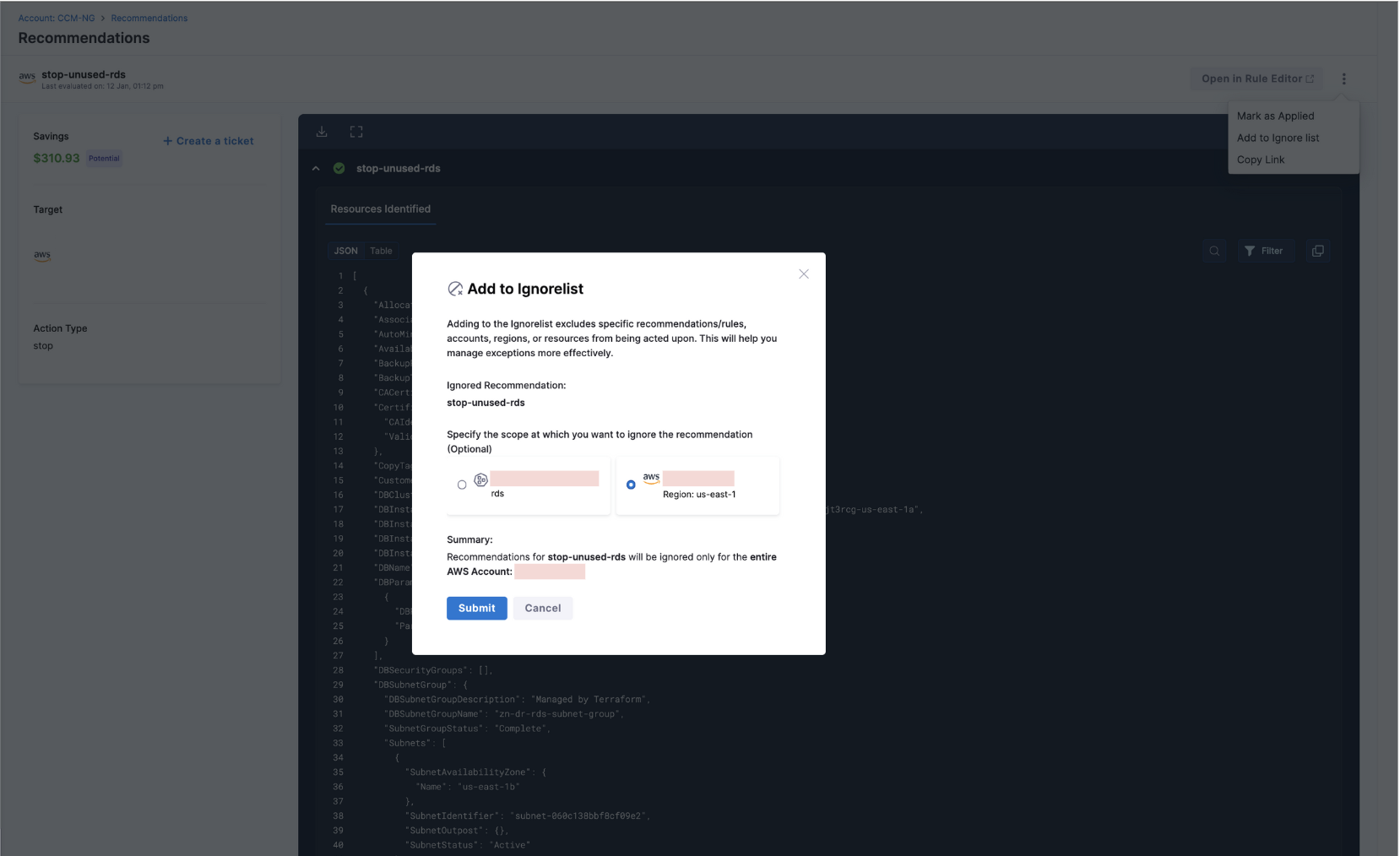
Recommendation: delete-unattached-aws-ebs
Description: Delete all ebs volumes which are unattached
Policy Used:
policies:
- name: delete-unattached-aws-ebs
resource: ebs
filters:
- Attachments: []
- State: available
actions:
- delete
Savings Computed: The policy identifies a list of resources on which potential savings are calculated by summing up cost of each resource for last 30 days.
Permissions Required:
- Dry Run:
ec2:DetachVolumeec2:DescribeVolumes
- Run Once:
ec2:DetachVolumeec2:DeleteVolumeec2:DescribeVolumes
Recommendation: list-low-request-count-aws-elb
Description: List ELBs with low request count
Policy Used:
policies:
- name: list-low-request-count-aws-elb
resource: elb
description: List ELBs with low request count
filters:
- type: metrics
name: RequestCount
statistics: Sum
days: 7
value: 7
missing-value: 0
op: less-than
Savings Computed: The policy identifies a list of resources on which potential savings are calculated by summing up cost of each resource for last 30 days.
Permissions Required:
-
Dry Run:
cloudwatch:GetMetricDataelasticloadbalancing:DescribeLoadBalancers
-
Run Once:
cloudwatch:GetMetricDataelasticloadbalancing:DescribeLoadBalancers
Recommendation: migrate-gp2-to-gp3-aws-ebs
Description: Migrate gp2 volumes to gp3
Policy Used:
policies:
- name: migrate-gp2-to-gp3-aws-ebs
resource: ebs
filters:
- VolumeType: gp2
- modifyable
actions:
- type: modify
volume-type: gp3
Savings Computed: The policy identifies a list of resources on which potential savings are calculated by summing up cost of each resource for last 30 days. Then, 20% of that sum is taken as the savings.
Permissions Required:
- Dry Run:
ec2:DescribeVolumeAttributeec2:DescribeVolumesModifications
- Run Once:
ec2:DescribeVolumeAttributeec2:ModifyVolumeAttributeec2:DescribeVolumesModifications
Recommendation: delete-volume-absent-aws-ebs-snapshot
Description: Delete snapshots with no volumes
Policy Used:
policies:
- name: delete-volume-absent-aws-ebs-snapshot
description: Find any snapshots that do not have a corresponding volume.
resource: aws.ebs-snapshot
filters:
- type: volume
key: VolumeId
value: absent
actions:
- delete
Savings Computed: The policy identifies a list of resources on which potential savings are calculated by summing up cost of each resource for last 30 days.
Permissions Required:
- Dry Run:
ec2:DescribeVolumes
- Run Once:
ec2:DescribeVolumesec2:DeleteSnapshot
Recommendation: stop-unused-aws-rds
Description: Stop unused RDS database
Policy Used:
policies:
- name: stop-unused-aws-rds
resource: rds
description: Stop unused RDS database
filters:
- type: value
key: DBInstanceStatus
value: available
- type: metrics
name: DatabaseConnections
statistics: Sum
days: 7
value: 0
op: equal
actions:
- stop
Savings Computed: The policy identifies a list of resources on which potential savings are calculated by summing up cost of each resource for last 30 days.
Permissions Required:
- Dry Run:
rds:DescribeDBInstances
- Run Once:
rds:DescribeDBInstancesrds:StopDBInstance
Recommendation: delete-unused-aws-elb
Description: Delete unused ELB
Policy Used:
policies:
- name: delete-unused-aws-elb
resource: elb
filters:
- Instances: []
actions:
- delete
Savings Computed: The policy identifies a list of resources on which potential savings are calculated by summing up cost of each resource for last 30 days.
Permissions Required:
- Dry Run:
elasticloadbalancing:DescribeLoadBalancers
- Run Once:
elasticloadbalancing:DescribeLoadBalancerselasticloadbalancing:DeleteLoadBalancer
Recommendation: release-unattached-aws-elastic-ip
Description: Release unattached Elastic IPs
Policy Used:
policies:
- name: release-unattached-aws-elastic-ip
resource: aws.elastic-ip
filters:
- AssociationId: absent
actions:
- release
Savings Computed: The policy identifies a list of resources on which potential savings are calculated by summing up cost of each resource for last 30 days.
Permissions Required:
- Dry Run:
ec2:DescribeAddresses
- Run Once:
ec2:DescribeAddressesec2:ReleaseAddress
Recommendation: delete-underutilized-aws-cache-cluster
Description: Delete underutilized cache cluster with CPU utilization less than 5% in the last 7 days.
Policy Used:
policies:
- name: delete-underutilized-aws-cache-cluster
resource: cache-cluster
description: |
Delete underutilised cache cluster with CPU utilisation less than 5% in last 7 days
filters:
- type: metrics
name: CPUUtilization
days: 7
period: 86400
value: 5
op: less-than
actions:
- type: delete
skip-snapshot: false
Savings Computed: The policy identifies a list of resources on which potential savings are calculated by summing up the cost of each resource for the last 30 days.
Permissions Required:
- Dry Run:
elasticache:DescribeCacheClusters
- Run Once:
elasticache:DescribeCacheClusterselasticache:DeleteCacheClusterelasticache:DeleteReplicationGroup
Recommendation: configure-lifecycle-aws-s3
Description: Configure lifecycle for S3 buckets wherever it is absent which would help to reduce storage spend
Policy Used:
policies:
- name: configure-lifecycle-aws-s3
resource: aws.s3
description: |
Configure lifecycle for s3 buckets wherever it is absent which would help to reduce storage spend
filters:
- type : value
key : Lifecycle
value : absent
actions:
- type: configure-lifecycle
rules:
- ID: harness-default-lifecycle
Status: Enabled
Filter:
Prefix: ''
Expiration:
ExpiredObjectDeleteMarker: True
AbortIncompleteMultipartUpload:
DaysAfterInitiation: 7
NoncurrentVersionExpiration:
NoncurrentDays: 30
NewerNoncurrentVersions: 6
Savings Computed: To estimate the percentage cost savings from the given S3 lifecycle policies, we need to look at the specific actions and apply some reasonable assumptions. Here's a step-by-step approach:
- Abort Incomplete Multipart Uploads after 7 days:
- Assumption: 5% of all uploads are incomplete and are not cleaned up without this policy.
- Cost Impact: Each incomplete multipart upload that is aborted saves the storage cost of the data uploaded so far.
- Expire Noncurrent Versions after 30 days (keeping 6 versions):
- Assumption: Each object has, on average, 10 noncurrent versions stored. Expiring noncurrent versions after 30 days, keeping only the latest 6, will delete 4 out of every 10 noncurrent versions.
- Cost Impact: Deleting 40% of noncurrent versions reduces the total storage used by these versions.
Example Calculation
Let's assume the following for a single S3 bucket:
Total Storage Used: 1 TB (1,024 GB) in the S3 Standard storage class.
Storage Distribution:
- Current versions: 50% (512 GB)
- Noncurrent versions: 40% (410 GB)
- Incomplete multipart uploads: 10% (102 GB)
Calculations:
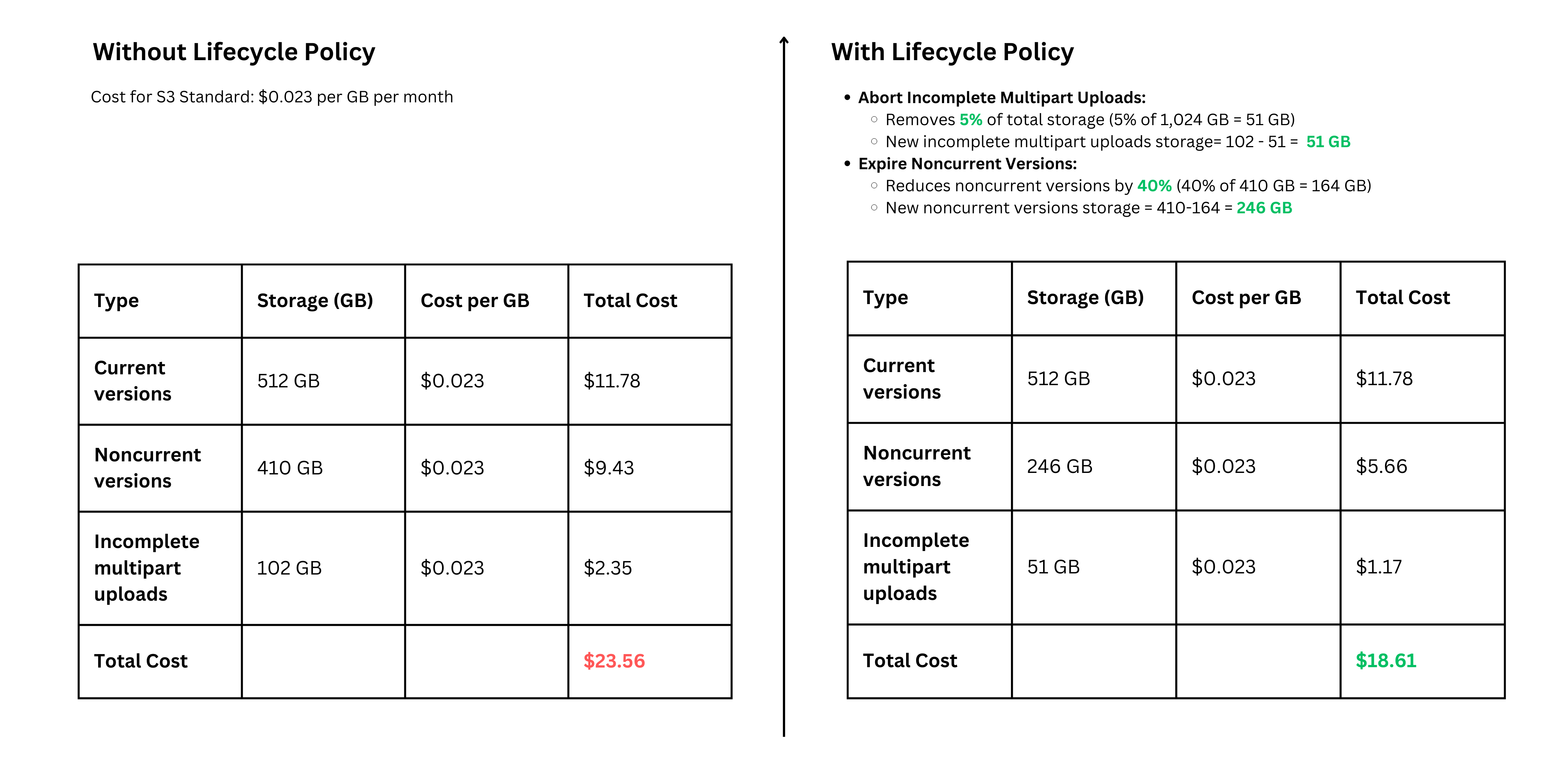
Total Savings
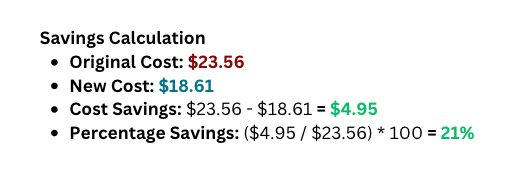
References:
Permissions Required:
- Dry Run:
s3:GetLifecycleConfiguration
- Run Once:
s3:GetLifecycleConfigurations3:PutLifecycleConfiguration
Recommendation: set-intelligent-tiering-aws-s3
Description: Configure intelligent tiering for S3 buckets wherever it is disabled which would help to reduce storage spend.
Policy Used:
policies:
- name: set-intelligent-tiering-aws-s3
resource: aws.s3
description: |
Configure intelligent tiering for s3 buckets wherever it is disabled which would help to reduce storage spend.
filters:
- not:
- type: intelligent-tiering
attrs:
- Status: Enabled
actions:
- type: set-intelligent-tiering
Id: harness-default
IntelligentTieringConfiguration:
Id: harness-default
Status: Enabled
Tierings:
- Days: 90
AccessTier: ARCHIVE_ACCESS
- Days: 180
AccessTier: DEEP_ARCHIVE_ACCESS
Savings Computed:
- Frequent Access Tier: This tier is equivalent in cost to the standard S3 storage, so no savings here.
- Infrequent Access Tier: Data not accessed for 30 days moves here, saving approximately 45% compared to standard S3 storage.
- Archive Instant Access Tier: Data not accessed for 90 days moves here, with savings of up to 68% compared to standard storage.
- Archive Access Tier: If configured, data not accessed for 90 days can move here, offering around 71% savings.
- Deep Archive Access Tier: Data not accessed for 180 days can be moved to this tier, providing up to 95% savings.
Example Calculation
Assume you have 1 TB of data stored in S3 standard storage:
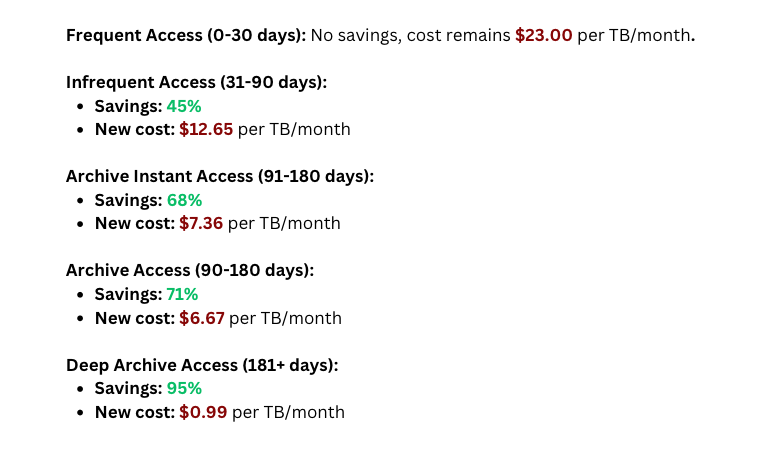
Example Scenario
If 20% of your data transitions to the Infrequent Access tier after 30 days, 20% moves to Archive Access after 90 days, and 10% moves to Deep Archive Access after 180 days, your costs might look like this:
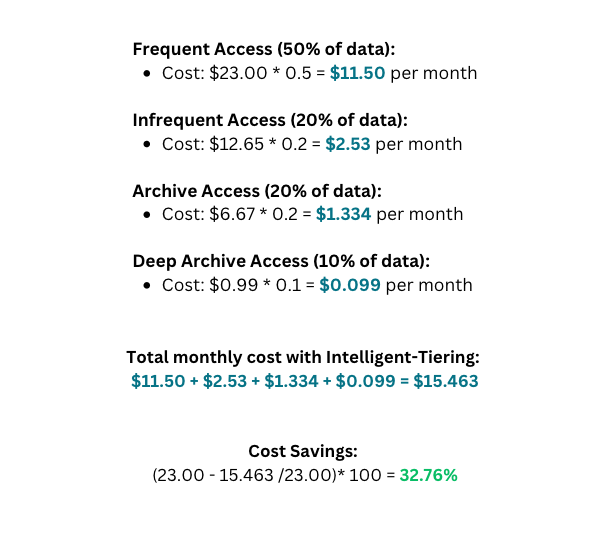
This results in a cost savings of approximately 32.76% compared to keeping all data in standard S3 storage (15.463 per month).
References:
Permissions Required:
- Dry Run:
s3:GetBucketIntelligentTieringConfiguration
- Run Once:
s3:GetBucketIntelligentTieringConfigurations3:PutIntelligentTieringConfiguration
Recommendation: delete-underutilized-aws-redshift
Description: Delete any Amazon Redshift cluster where CPU Utilization has been less than 5% for the last 7 days
Policy Used:
policies:
- name: delete-underutilized-aws-redshift
resource: redshift
description: |
Delete redshift cluster where CPU Utilization is less than 5% for last 7 days
filters:
- type: metrics
name: CPUUtilization
days: 7
period: 86400
value: 5
op: less-than
actions:
- delete
Savings Computed: The policy identifies a list of resources on which potential savings are calculated by summing up the cost of each resource for the last 30 days.
Permissions Required:
- Dry Run:
redshift:DescribeClusters
- Run Once:
redshift:DescribeClustersredshift:DeleteCluster
Recommendation: delete-old-manual-aws-redshift-snapshot
Description: Delete all redshift snapshots older than 35 days with a lifetime retention period
Policy Used:
policies:
- name: delete-old-manual-aws-redshift-snapshot
resource: redshift-snapshot
description: |
Delete all redshift snapshot older than 35 days with lifetime retention period
filters:
- "ManualSnapshotRetentionPeriod": -1
- type: age
days: 35
op: gt
actions:
- delete
Savings Computed: The policy identifies a list of resources on which potential savings are calculated by summing up the cost of each resource for the last 30 days.
Permissions Required:
- Dry Run:
redshift:DescribeClusterSnapshots
- Run Once:
redshift:DeleteClusterSnapshotredshift:DescribeClusterSnapshots
Recommendation: delete-empty-aws-dynamodb-table
Description: Delete DyanmoDB tables which are empty
Policy Used:
policies:
- name: delete-empty-aws-dynamodb-table
resource: dynamodb-table
description: |
Delete DyanmoDB tables which are empty
filters:
- TableSizeBytes: 0
actions:
- delete
Savings Computed: The policy identifies a list of resources on which potential savings are calculated by summing up the cost of each resource for the last 30 days.
Recommendation: delete-stale-aws-log-group
Description: Delete stale cloud watch log groups
Policy Used:
policies:
- name: delete-stale-aws-log-group
resource: log-group
description: |
Delete stale cloud watch log groups
filters:
- type: last-write
days: 60
actions:
- delete
Savings Computed: The policy identifies a list of resources on which potential savings are calculated by summing up the cost of each resource for the last 30 days.
Recommendation: delete-stale-aws-rds-snapshot
Description: Delete all stale(older than 28 days) RDS snapshots
Policy Used:
policies:
- name: delete-stale-aws-rds-snapshot
resource: rds-snapshot
description: |
Delete all stale(older than 28 days) RDS snapshots
filters:
- type: age
days: 28
op: ge
actions:
- delete
Savings Computed: The policy identifies a list of resources on which potential savings are calculated by summing up the cost of each resource for the last 30 days.
Recommendation: delete-unencrypted-aws-firehose
Description: Delete Firehose which are not encrypted
Policy Used:
policies:
- name: delete-unencrypted-aws-firehose
resource: firehose
description: |
Delete Firehose which are not encrypted
filters:
- KmsMasterKeyId: absent
actions:
- type: delete
Savings Computed: The policy identifies a list of resources on which potential savings are calculated by summing up the cost of each resource for the last 30 days.
Recommendation: delete-unencrypted-aws-sqs
Description: Delete SQS which are not encrypted
Policy Used:
policies:
- name: delete-unencrypted-aws-sqs
resource: sqs
description: |
Delete SQS which are not encrypted
filters:
- KmsMasterKeyId: absent
actions:
- type: delete
Savings Computed: The policy identifies a list of resources on which potential savings are calculated by summing up the cost of each resource for the last 30 days.
Recommendation: delete-unused-aws-nat-gateway
Description: Delete unused NAT Gateways based on no associated traffic in past 7 days.
Policy Used:
policies:
- name: delete-unused-aws-nat-gateway
resource: nat-gateway
description: |
Delete unused NAT Gateways based on no associated traffic in past 7 days.
filters:
- type: metrics
name: BytesOutToDestination
statistics: Sum
period: 86400
days: 7
value: 0
op: eq
actions:
- type: delete
Savings Computed: The policy identifies a list of resources on which potential savings are calculated by summing up the cost of each resource for the last 30 days.